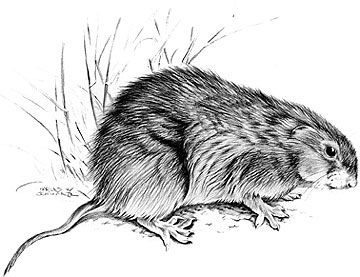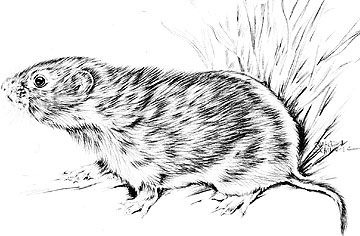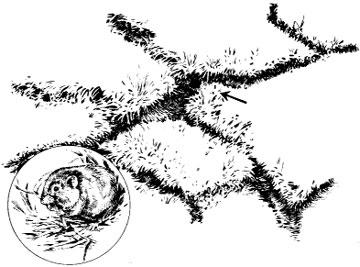 The body length of meadow voles (Microtus pennsylvanicus), top, and prairie voles (Microtus ochrogatser), bottom, varies from 4-1/2 to 7 inches.
The body length of meadow voles (Microtus pennsylvanicus), top, and prairie voles (Microtus ochrogatser), bottom, varies from 4-1/2 to 7 inches.

Meadow voles and prairie voles
Physical characteristics
- Eyes and ears visible
- Tail longer than hind legs
- Fur gray to dark brown
- Slightly larger than pine vole (3.5 to 5.0 inches long, weighs 1 to 2.5 ounces)
- Builds an extensive underground burrow system but spends considerable time and causes most damage above the ground
Reproduction
Female prairie and meadow voles have a gestation period of 21 days, have an average litter size of five, and produce four to ten litters per year. They reach sexual maturity at 40 days and have a reproductive life span of 1 to 2 years.
Ecology
These species spend most of their lives above ground, living in and feeding on grasses and seeds. They tend to have larger home ranges than pine voles and may travel as far as 1/4 mile in search of food and cover. The typical habitat for these voles includes lightly grazed pastures, old fields and grassy areas, lawns and gardens.
 The surface runway system of the prairie vole. Grass clippings are often left on floor of runway. The arrow points to the entrance to underground runway system
The surface runway system of the prairie vole. Grass clippings are often left on floor of runway. The arrow points to the entrance to underground runway system
Damage identification
Signs of prairie and meadow voles are found mostly above ground. Look for trails in the grass and grass clippings and check for feces at the base of large clumps of grass. Feces may be brown or green in color, are shaped like wheat grains, and are frequently left in small piles. Surface runways at the ground level usually lead to entrance holes, which are about 1-1/2 inch in diameter. Girdling of the tree at the ground level will reveal paired grooves left by their chisel-like teeth. Girdling completely around the tree trunk will kill the tree, so any indication of aboveground damage is cause for instituting a control program.
Rabbits also chew on young trees, but the girdling begins several inches above the soil line. Rabbits have much larger incisor teeth than voles, which will be reflected in the size of the grooves of the girdled tree. Rabbit damage can be controlled with a plastic tree guard, but these devices will not prevent damage from prairie or meadow voles.